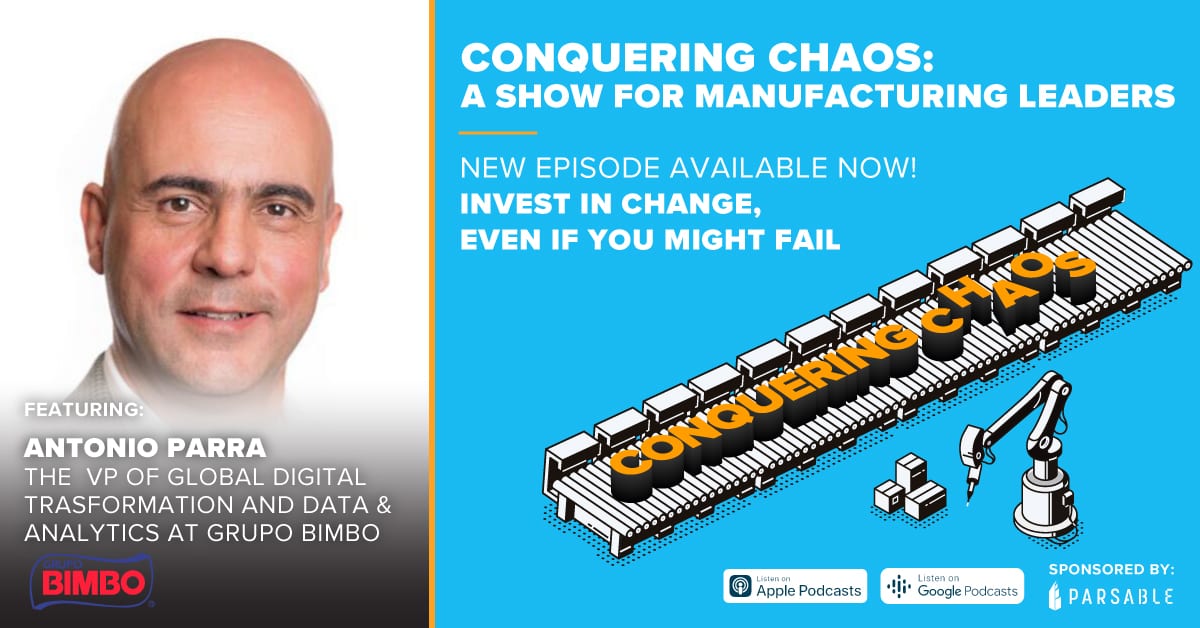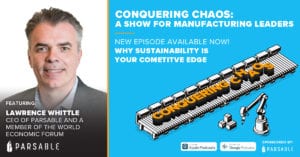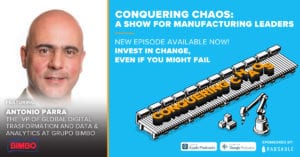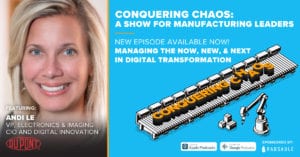Leading to Change

You know the old saying: “The only constant in life is change.”
The same goes for business. And the only risk greater than investing in change — digital transformation or otherwise — is avoiding change.
In this episode, we speak with Antonio Parra, the VP of Global Digital Transformation and Data & Analytics at Grupo Bimbo, about…
– Why digital transformation needs to be unique to the organization
– Why the change mentality has to go beyond your product
– How to build an organization for change
– Advice for organizations just beginning their digital transformation journey
______________________________________________________________________________________________________________
Are you ready to start your digital transformation journey? Request a demo today.

______________________________________________________________________________________________________________
Check out a snippet from the episode:
Welcome to the show. Our guest today is the current Vice President of Digital Transformation and Data & Analytics at Grupo Bimbo, which is the largest baking company in the world and produces many brands that I guarantee you, you know and love, and to be honest, a few of which are in my pantry right now. Prior to Grupo Bimbo, he spent 15 years with the Coca Cola company in supply chain management after getting his start at Procter & Gamble and even served a brief stint in the financial industry with the Royal Bank of Canada. To say that he is an experienced leader is an understatement. Ladies and gentlemen, Antonio Parra. Welcome to the show.
[00:01:16] Antonio: Thank you, Josh. Love to be here.
[00:01:18] Josh: How’s your day going so far?
[00:01:20] Antonio: Really good, very excited with the new year on its way, uh, faster than expected but, uh, somehow, I expected it.
[00:01:28] Josh: That’s right, I understand. Well look, serving as the Vice President of Digital Transformation and Data & Analytics, there’s a lot to unpack there. Would you mind just providing a quick description of what your responsibilities entail, and then what a day in life looks like for someone in your position?
[00:01:48] Antonio: Sure Josh. So, in terms of what I’m responsible for, it’s how to gather the different ideas and business needs and support them to become a reality through digital transformation. And that’s very interesting because it has to do with every business function, it has to do with every geographical, business unit in which we operate, so nobody escapes it.
So that’s very exciting because I have the chance and the privilege to work with everybody in the organization. And that is including the complete supply chain. So, I have the chance to look at the consumer, the customers, the manufacturing and distribution capabilities, sales, marketing, and even our suppliers. And that’s very exciting. So, in doing that, of course, I’m also in charge of looking at how data flows, and, how data from every interaction we have, or every idea we have, that’s translated into that and we hope to make out of that data the best possible decisions. Transforming that data into information, into different levels of information, looking at the past, looking at the present, and looking even into the future, and that’s again, very exciting. I can tell you, I love my job. I’ve spent most of my time and, in my career in supply chain, and supply chain was very exciting. I loved it, but I can tell you that this is kind of a new supply chain, data, information, and how we go about it. Because it provides you, from my perspective, a broader image.
So, going on how a typical day looks like, well, I’ll have to tell you, first of all, there’s no day similar to another. Every day is different, and it has a lot of surprises built into it. And not because I don’t have an agenda on the contrary, I, usually, my agenda is booked like three weeks in advance. I try really to make some pockets in-between just to accommodate for things I wasn’t prepared to. I don’t want to be missing any opportunities.
And on the other side, I don’t want to be working like midnight or really odd hours, but, of course, you have to do it sometimes because we deal with India, China, so all the places that have very different time zones as we do. And, sometimes you have to be prepared to work with them in real-time. And fortunately, that’s not every day so it’s a very good combination. I’ll have to say that I spend more time or more time in meetings than what I would like to.
[00:04:48] Josh: Hm.
[00:04:48] Antonio: I love to have more of a combination of getting to the problems physically when that’s possible, because now with a pandemic, that’s kind of challenging sometimes. But, uh, we’ve come to learn that being inside a problem remotely can also be very interesting. Into the future, we’d love to have that combination of being able to go physically and virtually through data and seeing and understanding the program, talking to the people because that’s where most of the ideas come from.
So, that’s the part, which I struggle a bit, to be honest, trying to reduce the number of interactions within meetings, and, of course, strive to make those meetings as much into the exploration area and to the decision making rather than just information, right?
[00:05:46] Josh: I think everyone can resonate with that idea of too many meetings. Are they the most effective? Are they even the ones that I really want to be having? How do I really make sure I’m in touch with the people with whom I need to work with to get those ideas, to understand what may not be bubbled up.
It sounds like a lot for one person to handle, especially when you know, what you brought up is that idea of not every day looking the same, which I know we all can relate to, planning for this is what my day is going to look like, and the second you start work, you have to do everything but those key things you intended to work on, I think we all can relate to that.
There are a couple of things that I want to unpack really quickly. You know, being someone who is responsible in the realm of digital transformation, digital transformation is very much a buzzword right now. It’s something that, yes, the industry acknowledges they’re moving toward, but it still is this bit– There’s-there’s debate about what that looks like and how to do it. So, if you wouldn’t mind, Tonio, I would love to hear from you your perspective on what digital transformation is.
[00:06:56] Antonio: Okay. So, the first thing I’ve come to think and reflect upon is that you have to define what digital transformation is to you. So, I can tell you my definition, and my definition changes over time because the business opportunities change over time. So, from my perspective, today is, digital transformation is understanding what the business opportunities are today, what the ambition those business opportunities will be in the near future, not the very far future because that’s very uncertain at this point, and then try to come with ways on how to make things better first for the consumer, then for our customers, and then for the way we operate within the company and that, uh, takes long the entire value chain, okay.
We want to be able to communicate within ourselves more effectively. We want to do it with less effort. And then we will be able to reduce the cost in which we operate, and we’ll be able to serve better our customers, reduce our cost going forward, and provide better payback to our shareholders. And so that is why digital transformation, taking those digital technologies just for the purpose of installing them, that’s kind of crazy.
Or you just have to be very bored and have to play with those things. If you want to take them seriously, you will have to choose the ones that help you fix the business problems for today and the near future, and then be ready for them to change, okay? Because your problem will be solved. One way, you will gain some traction, you will gain some, uh, speed, and then you will be having to be ready-to accelerate and to change for a new problem.
[00:09:05] Josh: So, I think that’s great. One of the key themes that you are bringing up pretty consistently in your answer is, one, it’s going to be evolving. So, you know, having a strong opinion loosely held is something that I’ve heard that’s really resonated with me. I love that idea of you have to define it for your own organization because ultimately, while you may be in a particular industry, you’re running your business a particular way and it may be similar to other businesses, but ultimately every business is unique.
It has its unique problems, its unique culture, unique working dynamics. So, understand what are those problems today, and then what are those things that you can do to fix those problems? And I love how you gave a priority matrix. You started specifically with first the consumers, then the customers, and then the operations, right?
Ultimately driving towards how you get to that point where it’s less effort to fix those problems in the day-to-day but be prepared as soon as you start making that traction, something’s going to happen. Whether that is something internally, new business demand, shifting consumer demand, or a world event like we all experienced in 2020, you have to be prepared to change and adapt.
Listen to find out how leading change is critical for your success.




